Back to Don's Maps
Back to Dolni Vestonice main page
Dolni Vestonice and Pavlov burials, including the triple burial
In the spring of 1986, the bodies of three teenagers were discovered in a common grave, near a village called Dolni Vestonice in the Czech province of Moravia. A specialist was immediately summoned from Brno and the remains were exhumed and faint remnants of the youths' identities revealed. Two of the skeletons were heavily built males. By its slender proportions, the third was judged to be female, aged seventeen to twenty. A marked left curvature of the spine, along with several other skeletal abnormalities, suggested that she had been painfully crippled. The two males had died healthy, in the prime of their lives. The remains of a thick wooden pole thrust through the hip of one of them hinted that his death might not have been entirely natural.
Text above: James Shreeve, The Neandertal Enigma (1995.)
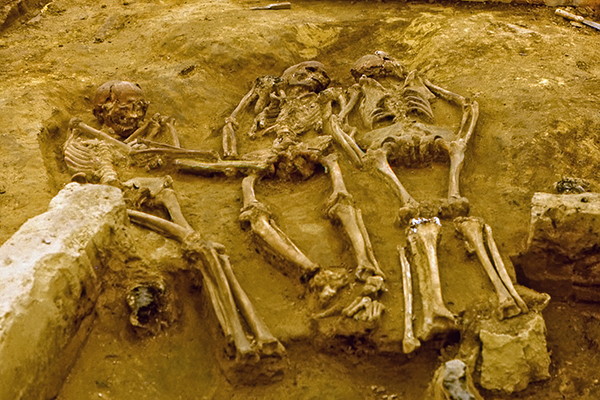
Dolni Vestonice triple burial.
From left to right: DV 13, DV 15, DV 14.
It is important to note that it has now been determined that all three of the skeletons were male, including the individual DV 15, whose sex has long been debated due to a pathological condition, were male.
( my thanks to AnnDee for the alert and access to the paper containing this information - Don )
Photo and text: Mittnik et al. (2016)
While reconstruction and interpretation of pre-historic events is a contentious exercise for archeologists, valuable insights into past social behaviour and attitudes toward death and afterlife can nevertheless be gained through the study of ancient burials.Text above: Mittnik et al. (2016)
The triple burial of Dolní Věstonice is especially intriguing due to the peculiarity of the individuals’ positioning–DV 13 on his side facing the central DV 15 with hands reaching the pubic region of the latter, and DV 14 laying face-down. The prominent central position of DV 15 is even more highlighted due to his pathological deformations. The fact that his sex was undeterminable by means of bone morphology and metrics suggests a unique character of this person and such individuals may have received a specific status in egalitarian societies. In addition, the three skeletons were covered partially in ochre and the whole situation was protected by burnt spruce logs and branches, obviously remains of a larger structure.
The sexing of the middle individual DV 15 as male gives us clues to the relationship the dead had to each other. The maternal kinship of DV 14 and DV 15 established by study of the mtDNA as well as their close age raises the possibility of them being brothers. A sibling relationship within the triple burial has been proposed before on the basis of skeletal variants present in all three individuals, however this type of analysis cannot be conclusive, as traits that are rare in extant populations might appear at higher frequency in smaller pre-historic communities due to endogamy. While a close maternal relationship of DV 13 to the other two individuals can be ruled out, a relationship to the degree of paternal half-brother cannot.
The causes of death cannot be established at this point, however, the male assignment of DV 15 rules out some proposed scenarios such as death during childbirth. This individual’s severe pathological condition might have led to his early death. The differential diagnosis as the X-linked form of CCP* (chondrodysplasia calcificans punctata) can now be considered less likely, as male individuals with the condition usually die in early childhood, however, adult male survivors have been reported in the literature and genetic mechanisms for this have been characterized.
*From Johnson et al. (1986) : Common features of chondrodysplasia punctata include short stature, short neck, congenital cataracts, flexion joint contractures, saddle nose deformity, and numerous dermatoses. Less frequent manifestations may include cardiac malformations, frontal bossing, malar hypoplasia, high-arched palate, and micrognathia. Affected individuals have no higher prevalence of mental retardation and motor retardation is rare. Mild to moderately affected individuals usually survive to adulthood and retain their reproductive capacity. Severely affected individuals usually die early in infancy.
The molecular sexing of these badly preserved DNA samples was made possible with a novel approach that takes into account the ratio of sequence alignments to chromosome X compared to the autosomes and which gives accurate results with as little as several thousands of reads mapping to the human genome. This method is therefore suitable for light shotgun sequencing data even of samples that contain only a small percentage of endogenous DNA or that are contaminated by modern human DNA. We also see an application of an adapted version of this approach to detect major chromosomal anomalies such as trisomy 21, conditions that were undoubtedly present in pre-historic populations but that can only tentatively be diagnosed in skeletal remains through anthropological methods.

The triple burial of Dolní Věstonice.
Photo: http://www.geocities.com/Athens/6293/series/bk4moravia.htm
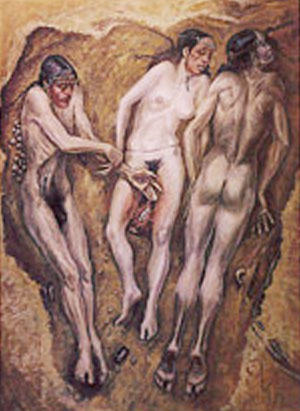
Dolni Vestonice burial reconstruction.
Photo: http://www.baselland.ch/docs/kultur/archaeologie/Pages/Publikationen/022.htm
Artist: Unknown
The following is taken from James Shreeve's book The Neandertal Enigma: solving the mystery of modern human origins (William Morrow and Company, New York, 1995.)
In the spring of 1986, near a village called Dolni Vestonice in the Czech province of Moravia, the bodies of three teenagers were discovered in a common grave. A specialist was immediately summoned from Brno, some twenty-five miles to the north, and under his care the remains were exhumed and faint remnants of the youths' identities revealed. Two of the skeletons were heavily built males. By its slender proportions, the third was judged to be female, aged seventeen to twenty. A marked left curvature of the spine, along with several other skeletal abnormalities, suggested that she had been painfully crippled. The two males had died healthy, in the prime of their lives. The remains of a thick wooden pole thrust through the hip of one of them hinted that his death might not have been entirely natural.
The bodies had been buried with curious attention. According to the expert Bohuslav Klima, of the Czech Institute of Archaeology in Brno both young men had been laid to rest with their heads encircled with necklaces of pierced canine teeth and ivory; the one with the pole thrust up to his coccyx may also have been wearing some kind of painted mask. All three skulls were covered in red ocher. The most peculiar feature of the grave, however, was the arrangement of the deceased. Whoever committed the bodies to the ground extended them side by side, the woman between her two companions. The man on her left lay on his stomach, facing away from her but with his left arm linked with hers. The other male lay on his back, his head turned toward her. Both of his arms were reaching out, so that his hands rested on her pubis. The ground surrounding this intimate connection was splashed with red ocher.
The skeletons lean into each other, like nestled question marks. In his written report, Klima speculated that the arrangement of the grave might reflect "a real life drama which precipitated the burials." His drama revolved around a young woman who had died in childbirth. The two male skeletons where those of her husband and a medicine man-the man wearing the mask. Held responsible for her death, the men had been compelled to follow her into the afterlife.
From:
http://www.geocities.com/Athens/6293/series/bk4moravia.htm
In August, 1986 this multiple burial was unearthed. It was a shallow pit grave located near hearths carbon-dated to about 26,000 years ago. The remains were of an individual of undetermined sex in the center, who had spinal scoliosis, an asymmetrical skull, and an underdeveloped right leg. On the left is a male reaching toward some red ochre located between the legs of the middle body. A larger male on the right is laying face down. The male skulls were adorned with circles of arctic fox teeth, wolf teeth and ivory beads.
From the book 'Plains of Passage' by Jean Auel:
Stretched out on the ground were three people - young, probably late teens or early twenties, he guessed. Two of them were definitely male; they were bearded. The biggest one was probably the youngest. His light facial hair was still somewhat sparse. ... The third one was fairly tall but thin, and something about the body and the way it lay made him wonder if that person had had some physical problem. He could see no facial hair, which made him think it was a woman at first, but it also could have been a rather tall young man who shaved, just as easily.
With no burial shrouds, the bodies were simply carried to a single shallow grave one at a time. ... The tall, thin body went in first, placed on its back, and powdered red ochre was sprinkled on the head and, strangely, over the pelvis; the powerful generative area, making Jondalar wonder if, perhaps, it was indeed a woman.
The other two were handled differently, but even more strangely. The brown-haired male was put in the common grave, to the left of the first corpse from Jondalar's viewpoint, but on the figure's right, and placed on his side, facing the first body. Then his arm was stretched out so that his hand rested on the red-ochred pubic region of the other. The third body was almost thrown into the grave, facedown, on the right side of the body that had been put in first. Red ochre was also sprinkled on both of their heads. The sacred red powder was obviously meant for protection, but for whom? And against what?
From:
http://emuseum.mnsu.edu/archaeology/sites/europe/dolni_vestonice.html
"Where the two rivers came together and the wet ground sustained the tender grasses of spring, the woolly mammoth...grazed, and the people...hunted and lived on the swamp." -James Shreeve
Dolni Vestonice was an Upper Paleolithic habitation in Czechoslovakia on a swamp at the joint of two rivers near the Moravian mountains. In the spring of 1986, near the village of Dolni Vestonice, the remains of three teenagers were discovered in a common grave. Approximatley 27,640 years had passed from the time of the burial until they were found. Two of the skeletons were heavily built males while the third was judged to be a female based on its slender proportions. Archaeologists who examined her skeletal remains found evidence of a stroke or other illness which left her painfully crippled and her face deformed. The two males had died healthy, but remains of a thick wooden pole thrust through the hip of one of them suggests that the death didn't happen naturally. On the ground surrounding the burial site, red ocher powder was splashed, which was thought to be for protection.
Dolni Vestonice is also the site of the earliest known potter's kiln. For acres around, the fertile clay soil is seeded with carved and molded images of animals, women, strange engravings, personal ornaments, and decorated graves. In the main hut, where the people ate and slept, two items were found: a goddess figurine made of fired clay and a small and cautiously carved portrait made from mammoth ivory of a woman whose face was drooped on one side.
The goddess figurine is the oldest known baked clay figurine. On top of its head are holes which may have held grasses or herbs. The potter scratched two slits that stretched from the eyes to the chest which were thought to be the life-giving tears of the mother goddess.
Above the encampment in a small, dry-hut, whose door faced towards the east, was the kiln. Scattered around the oven were many fragments of fired clay. Remains of clay animals, some stabbed as if hunted, and other pieces of blackened pottery still bear the fingerprints of the potter.
From:
http://www.calacademy.org/calwild/sum99/symbol.htm
Some 26,000 years ago, a resident of a seasonal, open-air encampment in what is now the southern Czech Republic kneaded moist clay mixed from local soil into an exaggerated portrait of a woman. The so-called Black Venus of Dolni Vestonice I has a featureless, possibly masked, face, squared shoulders, pendulous breasts, and a belt beneath her broad hips. Only four inches tall, she is one of the earliest known depictions of a female figure, but what inspired her creation is cloaked in mystery.
A jagged crack runs along her right hip, damage sustained when the clay figurine was fired in a kiln at temperatures up to 1,500 °F. More than 700 figurines-nearly all depicting Ice Age animals such as lions, rhinos, and mammoths-were fired in the oval earthen kilns of Dolni Vestonice. At nearby sites of similar age, thousands more terracotta figurines and clay pellets have been excavated. Almost all the Vestonice figurines exhibit breaks and cracks-the shattering shock of the flames that baked them. Were the world's first ceramic artists also the world's worst craftsmen, or were these figures props for a pyrotechnic ritual?
Elsewhere at Dolni Vestonice, a grave excavated in 1986 contained the skeletons of two young men and a woman. Inside the shallow burial pit lay bits of reindeer bones, and wolf and fox teeth. Red ocher powder had been sprinkled around each skull and between the legs of the female, who had a deformed spine and right leg. One male's hand had been placed atop the female's pelvis, while the other male's skull had been smashed at the time of burial.
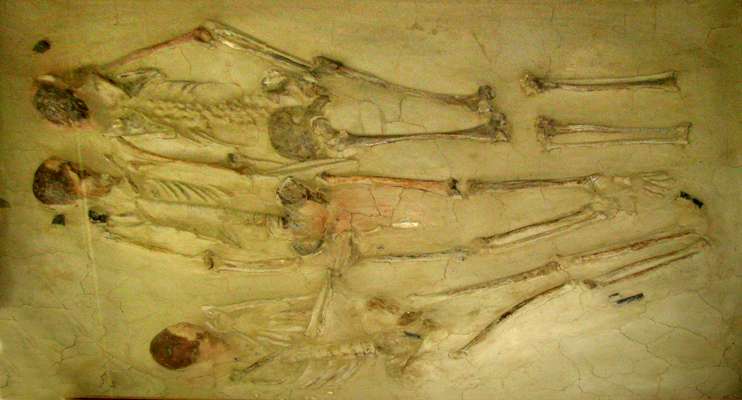
This is a recreation of the triple burial in the Dolní Věstonice Museum in the small village of Dolní Věstonice, Czech Republic. Unfortunately it is not as detailed as it could have been.
Photo: Don Hitchcock 2008
Source: Facsimile, Dolní Věstonice Museum
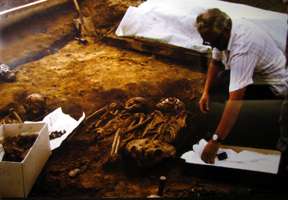
The burial during its exhumation.
Source: Display, Dolní Věstonice Museum
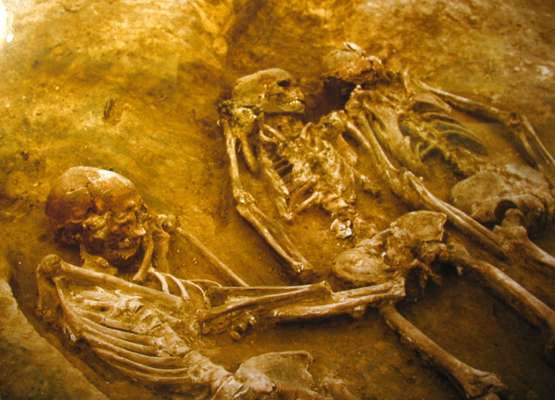
General view of the burial.
Photo source: Display, Dolní Věstonice Museum
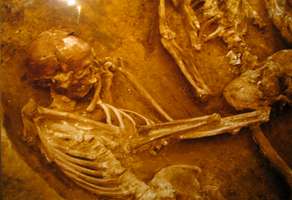
Close up of part of the burial.
Photo source: Display, Dolní Věstonice Museum

Artist's impression of the triple burial, as well as a recreation of one of the skulls with the jewellery found with the body.
My thanks to Eva Pecháčková for identifying the painter of this work as Pavel Dvorský.
Pavel Dvorský was born in Brno on 8 September 1946. From 1962, he was a student of Illustration at the Dalibor Chatrný Secondary School of Arts and Crafts in Brno, graduating in 1966. From 1966 to 1972, he studied Illustration in the studio of Jiří Trnka and Zdeněk Sklenář at the Academy of Arts, Architecture and Design in Prague.
After his studies, Pavel Dvorský returned to Brno, where he works as a commercial and graphic artist. He has illustrated dozens of publications, with scientific and popular-scientific themes predominating. Among his most important works are his reconstructions of the prehistoric world in collaboration with anthropologists and archaeologists including Jan Jelínek, Karel Sklenář, Jan Beneš, Bořivoj Záruba, Jiří A. Svoboda, Luděk Seitl, Radan Květ and Petr Neruda.
Photo and text: Display, Dolní Věstonice Museum
Artist: Pavel Dvorský
Additional text: https://www.albatrosmedia.eu/illustrator/pavel-dvorsky/
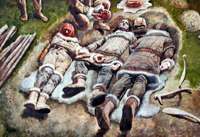
Another reconstruction of the Dolni Vestonice triple burial.
Artist: Illustration © Libor Balák
Photo: http://www.iabrno.cz/agalerie/pavlova.htm
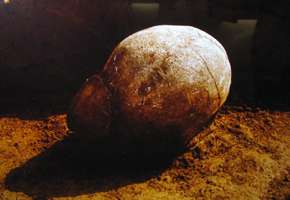
Near the triple burial lay a solitary human skull.
Photo source: Display, Dolní Věstonice Museum

Brain casts from Pavlov 1 and Dolní Věstonice 13 and 16.
Photo: Don Hitchcock 2008
Source: Display, Dolní Věstonice Museum
Dolni Vestonice II
The following are extracts from the Eric Trinkaus site: http://artsci.wustl.edu/~anthro/blurb/b_trink.html
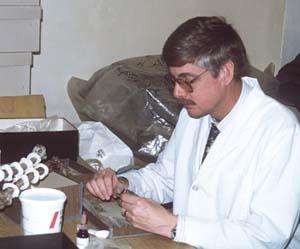
The excavation and paleoanthropological analysis of the early Upper Paleolithic site of Dolni Vestonice II has yielded a series of incomplete and isolated human remains, comprising cranial vaults, teeth (including a series from an infant), ribs, arm bones, hand phalanges, leg bones, tarsals, metatarsals and pedal phalanges. Morphologically and morphometrically the elements are similar to those from buried individuals at Dolni Vestonice I and II ( III? ) and Pavlov I, as well as to other European early Upper Paleolithic human remains. They differ principally in the high percent cortical areas of the distal humerus and femur. The Dolni Vestonice 36 infant's teeth may well derive from an undisturbed burial with in situ bone destruction. Geological processes are unlikely to have produced the taphonomic patterns observed, and the preservation and damage patterns of the elements (other than Dolni Vestonice 36) suggests that the original bodies were processed by some combination of scavenging agents. Moreover, the original number of burials at Dolni Vestonice II may have been greater than the four currently known.
Dolni Vestonice II (Fig. 1) occupies one of the loess elevations at an altitude of ca.240m, rising above the Dyje River toward the Pavlovian Hills (altitude 550m). The central parts of this site were excavated as a salvage project during industrial loess exploitation between 1985-1991.
The site is one of the largest hunter-gatherer settlements in Moravia. However, a lower density of the occupations, less stable dwelling structures, a rarity of art objects, and other characters of archaeological record suggest that Dolni Vestonice II was not settled as densely as the nearby sites of Pavlov I and Dolni Vestonice I. Dolni Vestonice II was probably occupied repeatedly, but in a more time-limited manner and with more specialized functions.
On August 13, 1986, inside the same settlement concentration, the exceptionally well preserved triple burial was unearthed (DV 13 to 15), probably covered originally by burnt spruce logs and branches (Klima, 1987a). On April 28, 1987, in another settlement concentration near a hearth on the western slope of this site, a male burial (DV 16) was uncovered (Svoboda, 1987).
A consideration of the postmortem damage on the isolated human remains from the Dolni Vestonice II site indicates that geological processes (other than sediment compaction and minor erosion) are unlikely to have produced the taphonomic patterns observed, but that human and/or carnivore processing of the bodies were responsible for the observed distribution. Given the limited range of skeletal elements represented among these isolated remains, agents which systematically destroy bones (large carnivores) seem more likely to have been involved than less destructive agents (humans and small carnivores). Regardless of the original processes involved, it is nonetheless apparent that there were considerably more human burials at Dolni Vestonice II (and probably other earlier Upper Paleolithic sites) than is indicated by the well-preserved human burials.
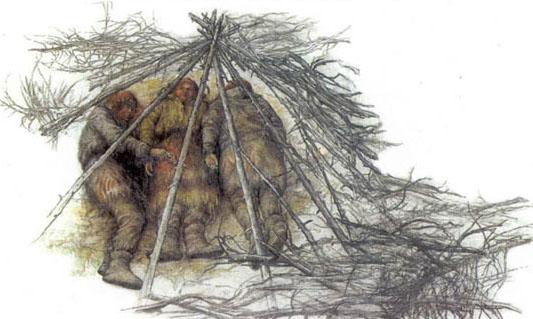
This is a recreation of the triple burial at Dolní Věstonice.
Photo: http://artsci.wustl.edu/~anthro/blurb/trinkcover.html
Artist: Pavel Dvorský

Paired right clavicles (cranial view) and humeri (anterior view) for Late Pleistocene humans.
Neandertals: La Ferrassie 1 (Ferr1) and Regourdou 1 (Reg1).
Upper Paleolithic modern humans: Dolní Věstonice 13 (DV13), Pataud 5 (Pat5), and Sunghir 1 (Su1).
Note that for all clavicle–humerus pairs except Regourdou 1, both bone images derive from the same original photograph, and hence there is no issue of scaling distortion.
Photo and text: Trinkaus et al. (2014)
A separate burial at Dolni Vestonice of a single, older male
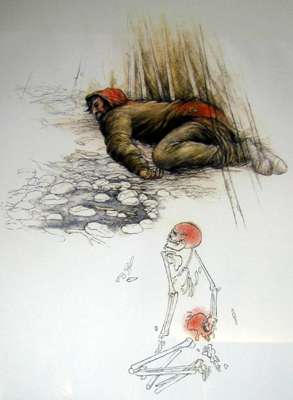
Older lone man from Dolní Věstonice, probably buried inside a hut. The age of this burial is 25 570 ± 280 years. Traces of red ochre were found on his skull and pelvis.
Photo and text: Display, Dolní Věstonice Museum
Artist: Pavel Dvorský

Recording the position of the male skeleton.
Photo source: Display, Dolní Věstonice Museum
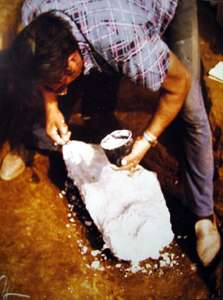
Before the skeleton could be moved, it was necessary to stabilise it with plaster.
Photo source: Display, Dolní Věstonice Museum

The grave during the course of the research. Near the knee of the skeleton a hearth was uncovered.
Photo source: Display, Dolní Věstonice Museum
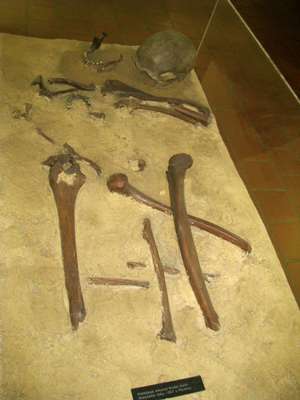
A reconstruction using facsimiles of the burial, as it was found, of the bones of a man unearthed in 1957 at Pavlov.
Photo: Don Hitchcock 2008
Source: Facsimiles, display, Dolní Věstonice Museum
References
- Johnson J. et al., 1986: Chondrodysplasia punctata: case report with dental findings, The American Academy of Pediatric Dentistry, Volume 8 Number 2 CAS
- Mittnik A., Wang C-C., Svoboda J., Krause J. , 2016: A Molecular Approach to the Sexing of the Triple Burial at the Upper Paleolithic Site of Dolní Věstonice, PLoS ONE , 11(10): e0163019. https://doi.org/10.1371/journal.pone.0163019
- Trinkaus, E., Holliday T., Auerbach B., 2014: Neandertal clavicle length PNAS, 2014 ; published ahead of print March 10, 2014